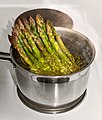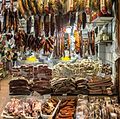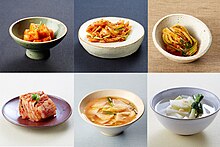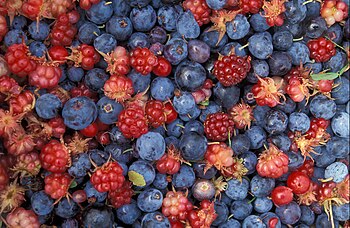Portal:Food
F o o d
A portal dedicated to food and foodways
Introduction
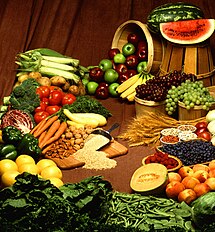
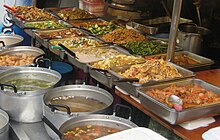
Food is any substance consumed by an organism for nutritional support. Food is usually of plant, animal, or fungal origin and contains essential nutrients such as carbohydrates, fats, proteins, vitamins, or minerals. The substance is ingested by an organism and assimilated by the organism's cells to provide energy, maintain life, or stimulate growth. Different species of animals have different feeding behaviours that satisfy the needs of their metabolisms and have evolved to fill a specific ecological niche within specific geographical contexts.
Omnivorous humans are highly adaptable and have adapted to obtaining food in many different ecosystems. Humans generally use cooking to prepare food for consumption. The majority of the food energy required is supplied by the industrial food industry, which produces food through intensive agriculture and distributes it through complex food processing and food distribution systems. This system of conventional agriculture relies heavily on fossil fuels, which means that the food and agricultural systems are one of the major contributors to climate change, accounting for as much as 37% of total greenhouse gas emissions. (Full article...)
Cooking, also known as cookery or professionally as the culinary arts, is the art, science and craft of using heat to make food more palatable, digestible, nutritious, or safe. Cooking techniques and ingredients vary widely, from grilling food over an open fire, to using electric stoves, to baking in various types of ovens, reflecting local conditions. Cooking is an aspect of all human societies and a cultural universal.
Preparing food with heat or fire is an activity unique to humans. Archeological evidence of cooking fires from at least 300,000 years ago exists, but some estimate that humans started cooking up to 2 million years ago.
The expansion of agriculture, commerce, trade, and transportation between civilizations in different regions offered cooks many new ingredients. New inventions and technologies, such as the invention of pottery for holding and boiling of water, expanded cooking techniques. Some modern cooks apply advanced scientific techniques to food preparation to further enhance the flavor of the dish served. (Full article...)
Salade niçoise (French pronunciation: [saˈlad niˈswaz]; Occitan: salada niçarda, pronounced [saˈlaðo niˈsaɾðo], or salada nissarda in the Niçard dialect) is a salad that originated in the French city of Nice. It is traditionally made of tomatoes, hard-boiled eggs, Niçoise olives and anchovies or tuna, dressed with olive oil, or in some historical versions, a vinaigrette. It has been popular worldwide since the early 20th century, and has been prepared and discussed by many chefs. Delia Smith called it "one of the best combinations of salad ingredients ever invented" and Gordon Ramsay said that "it must be the finest summer salad of all".
Salade niçoise can be served either as a composed salad or as a tossed salad. Freshly cooked or canned tuna may be added. For decades, traditionalists and innovators have disagreed over which ingredients should be included; traditionalists exclude cooked vegetables. The salad may include raw red peppers, shallots, artichoke hearts and other seasonal raw vegetables. Raw green beans harvested in the spring, when they are still young and crisp, may be included. However, cooked green beans and potatoes are commonly served in variations of salade niçoise that are popular around the world. (Full article...)
Selected article –
A pretzel (/ˈprɛtsəl/ ⓘ PRET-səl; from German: Breze(l) or Bretzel, pronounced [ˈbʁeːtsl̩] ⓘ or [ˈbʁɛtsl̩]) is a type of baked pastry made from dough that is commonly shaped into a knot. The traditional pretzel shape is a distinctive symmetrical form, with the ends of a long strip of dough intertwined and then twisted back onto itself in a particular way (a pretzel loop or pretzel bow). Today, pretzels come in various shapes, textures, and colors, but the original soft pretzel is still one of the most common pretzel types to date.
Salt is the most common seasoning, or topping, for pretzels, complementing the washing soda or lye treatment that gives pretzels their traditional skin and flavor acquired through the Maillard reaction. Other toppings are mustard, cheeses, sugar, chocolate, cinnamon, sweet glazing, seeds, and nuts. Varieties of pretzels include soft pretzels, which should be eaten shortly after preparation, and hard-baked pretzels, which have a long shelf life. (Full article...)
Selected cuisine -
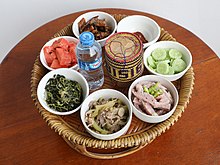
Lao cuisine or Laotian cuisine (Lao: ອາຫານລາວ, pronounced [ʔàː.hǎːn láːw], RTGS: ahan lao) is the national cuisine of Laos.
The staple food of the Lao is sticky rice (Lao: ເຂົ້າໜຽວ, khao niao, [kʰȁw nǐaw]). Laos has the highest sticky rice consumption per-capita in the world with an average of 171 kilograms (377 lb) of sticky rice consumed annually per person. Sticky rice is deeply ingrained in the culture, religious tradition, and national identity of Laos. It is a common belief within the Lao community that no matter where they are in the world, sticky rice will always be the glue that holds the Lao communities together, connecting them to their culture and to Laos. Affinity for sticky rice is considered the essence of what it means to be Lao. Often the Lao will refer to themselves as luk khao niao (Lao: ລູກເຂົ້າໜຽວ, [lùːk kʰȁw nǐaw]), which can be translated as 'children or descendants of sticky rice'. (Full article...)
Selected ingredient –
Breadcrumbs, also known as breading, consist of crumbled bread of varying dryness, sometimes with seasonings added, used for breading or crumbing foods, topping casseroles, stuffing poultry, thickening stews, adding inexpensive bulk to soups, meatloaves and similar foods, and making a crisp and crunchy covering for fried foods, especially breaded cutlets like tonkatsu and schnitzel. The Japanese variety of breadcrumbs is called "panko". (Full article...)
Selected recipe –
Kimchi (/ˈkɪmtʃiː/; Korean: 김치; RR: gimchi, IPA: [kim.tɕʰi]) is a traditional Korean side dish (banchan) consisting of salted and fermented vegetables, most often napa cabbage or Korean radish. A wide selection of seasonings are used, including gochugaru (Korean chili powder), spring onions, garlic, ginger, and jeotgal (a salted seafood). Kimchi is also used in a variety of soups and stews. Kimchi is a staple food in Korean cuisine and is eaten as a side dish with almost every Korean meal.
There are hundreds of different types of kimchi made with different vegetables as the main ingredients. Traditionally, winter kimchi, called gimjang, was stored in large earthenware fermentation vessels, called onggi, in the ground to prevent freezing during the winter months and to keep it cool enough to slow down the fermentation process during summer months. The process of making kimchi was called kimjang and was a way for the whole village to participate. The vessels are also kept outdoors in special terraces called jangdokdae. In contemporary times, household kimchi refrigerators are more commonly used. (Full article...)
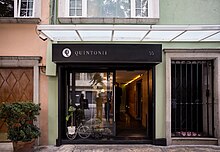
As of the 2024 Michelin Guide edition, there are eighteen restaurants in Mexico with a Michelin-star rating. The Michelin Guides have been published by the French tire company Michelin since 1900. They were designed as a guide to tell drivers about eateries they recommended to visit and to subtly sponsor their tires, by encouraging drivers to use their cars more and therefore need to replace the tires as they wore out. Over time, the stars that were given out became more valuable.
The Michelin Guide debuted in Mexico in 2024. Inspectors visited five states—Baja California, Baja California Sur, Nuevo León, Oaxaca, and Quintana Roo—and the capital city, Mexico City. Sixteen restaurants earned one star and two, Pujol and Quintonil, received two. No restaurant earned three stars. Among the awarded restaurants, Michelin included a taco stand, Taquería El Califa de León. Gwendal Poullennec, international director of the Michelin Guides, said it took time to choose which restaurants to visit. He added that 11 Mexican food restaurants in other countries had one Michelin star, and two had two as of 2023. (Full article...)
Selected image –
Selected biography –
MFK Fisher
B. July 3, 1908 – d. June 22, 1992
Mary Frances Kennedy Fisher Parrish Friede (July 3, 1908 – June 22, 1992), writing as M.F.K. Fisher, was an American food writer. She was a founder of the Napa Valley Wine Library. Over her lifetime she wrote 27 books, among them Consider the Oyster (1941), How to Cook a Wolf (1942), The Gastronomical Me (1943) and a translation of Brillat-Savarin's The Physiology of Taste. Fisher believed that eating well was just one of the "arts of life" and explored this in her writing. W. H. Auden once remarked, "I do not know of anyone in the United States who writes better prose." In 1991 the New York Times editorial board went so far as to say, "Calling M.F.K. Fisher, who has just been elected to the American Academy and National Institute of Arts and Letters, a food writer is a lot like calling Mozart a tunesmith. At the same time that she is celebrating, say, oysters (which lead, she says, 'a dreadful but exciting life') or the scent of orange segments drying on a radiator, she is also celebrating life and loneliness, sense and sensibility." (Full article...)
Did you know (auto-generated) –

- ... that Sister Maureen Keleher said that the first freestanding hospice in Hawaii was like an answer to prayer?
- ... that because of the increasing prevalence of sesame allergy, the U.S. will join the EU and Canada in 2023 in instituting mandatory food labeling?
- ... that certain Coccinellidae species lay extra infertile trophic eggs along with their fertile eggs so that their larvae can have a backup food source?
- ... that the Korean stew budae-jjigae commonly includes baked beans, Spam, corn, and American cheese?
- ... that within the Armenian Rite, it takes 40 days and more than 40 flowers, herbs, and spices to create the chrism known as myron?
- ... that before Angeli Foods was sold this year, the first self-service grocery store in the Upper Peninsula of Michigan had been owned by three generations of a single family?
More did you know –
Related portals
Food topics
The following are topics relating to food
Categories
Food list articles
- See also: Lists of foods and Category:Lists of drinks
The following are some Food list articles on Wikipedia:

- American cheeses
- Appellation d'Origine Contrôlée cheeses
- Apple cultivars
- Bacon dishes
- Bacon substitutes
- Basil cultivars
- Breads
- Breakfast beverages
- Breakfast cereals
- Breakfast foods
- British cheeses
- Cakes
- Candies
- Cheeses
- Cheese soups
- Christmas dishes (list)
- Cocktails
- Cookies
- Dishes using coconut milk
- Diets
- Doughnut varieties
- Egg dishes
- Fermented soy products
- Food additives
- Food additives (Codex Alimentarius)
- Foods named after people
- French cheeses
- French dishes
- Fried dough foods
- Fruits
- List of hamburgers
- Herbs and spices
- Hors d'oeuvre
- Indian dishes
- Indian snack foods
- Indonesian dishes
- Italian dishes
- Japanese snacks
- Japanese dishes
- Jewish dishes
- Kebabs
- Korean beverages
- Mango cultivars
- Moroccan dishes
- Pasta
- Pastries
- Philippine snack food
- Pies, tarts and flans
- Poppy seed pastries and dishes
- Potato dishes
- Puddings
- Raw fish dishes
- Rice dishes
- Rolled foods
- Sauces
- Seafood
- Seeds
- Sandwiches
- Snack foods
- Soft drinks by country
- Soul foods and dishes
- Soups
- Stews
- Street foods
- Tapas
- Turkish dishes
- Twice-baked foods
- Vegetable oils
- Vegetables
- Vodkas
Things you can do
Related WikiProjects
| Parent project: WikiProject Food and Drink | |
| Child projects: | Task forces: (All inactive) |
|
|
| Related projects: | |
New articles
Rules | Match log | Results page (for watching) | Last updated: 2025-02-09 19:18 (UTC)
Note: The list display can now be customized by each user. See List display personalization for details.
- Paniel Meat Processing (edit | talk | history | links | watch | logs | tools) by 24eeWikiUser (talk · contribs · new pages (6)) started on 2025-02-09, score: 10
- Cucumber salad (edit | talk | history | links | watch | logs | tools) by Shirt58 (talk · contribs · new pages (3)) started on 2025-02-09, score: 10
- Ed Cordero (edit | talk | history | links | watch | logs | tools) by YssaLang (talk · contribs · new pages (11)) started on 2025-02-09, score: 10
- Cocoa bean fermentation (edit | talk | history | links | watch | logs | tools) by Rollinginhisgrave (talk · contribs · new pages (4)) started on 2025-02-09, score: 20
- Dek Akeo (edit | talk | history | links | watch | logs | tools) by Emma Oruk (talk · contribs · new pages (6)) started on 2025-02-08, score: 10
- Dill pickle chip (edit | talk | history | links | watch | logs | tools) by Clovermoss (talk · contribs · new pages (55)) started on 2025-02-04, score: 20
- Favour Fawunmi (edit | talk | history | links | watch | logs | tools) by Hildreth gazzard (talk · contribs · new pages (184)) started on 2025-02-08, score: 10
- Speed (energy drink) (edit | talk | history | links | watch | logs | tools) by AlviRMahi (talk · contribs · new pages (3)) started on 2025-02-05, score: 20
- 200 Proven Recipes for Dishes, Pastries and Other Household Works (edit | talk | history | links | watch | logs | tools) by Iurii.s (talk · contribs · new pages (1)) started on 2025-02-05, score: 10
- Salt and vinegar chip (edit | talk | history | links | watch | logs | tools) by Clovermoss (talk · contribs · new pages (55)) started on 2025-02-04, score: 30
- Oompa-Loompas (edit | talk | history | links | watch | logs | tools) by 81.133.25.210 (talk · contribs · new pages (0)) started on 2025-01-25, score: 10
- Culmination Brewing (edit | talk | history | links | watch | logs | tools) by Another Believer (talk · contribs · new pages (97)) started on 2025-02-07, score: 10
- 2025 Chili's Ride the 'Dente 200 (edit | talk | history | links | watch | logs | tools) by Brycenrichter (talk · contribs · new pages (10)) started on 2025-02-05, score: 10
- Maryam's Bread (edit | talk | history | links | watch | logs | tools) by Ahmed (talk · contribs · new pages (1)) started on 2025-02-05, score: 10
- Angie O'Steen (edit | talk | history | links | watch | logs | tools) by Moondragon21 (talk · contribs · new pages (100)) started on 2025-02-05, score: 10
- True Fruits (edit | talk | history | links | watch | logs | tools) by Snowyday99 (talk · contribs · new pages (1)) started on 2025-02-05, score: 10
- Spaghett (edit | talk | history | links | watch | logs | tools) by BanjoZebra (talk · contribs · new pages (4)) started on 2025-02-04, score: 40
- Dianaruthe Wharton (edit | talk | history | links | watch | logs | tools) by Miraclepine (talk · contribs · new pages (20)) started on 2025-02-01, score: 10
- Nagqu Horse Racing Festival (edit | talk | history | links | watch | logs | tools) by TinaLees-Jones (talk · contribs · new pages (103)) started on 2025-02-04, score: 20
- Yalong Cultural Tourism Festival (edit | talk | history | links | watch | logs | tools) by TinaLees-Jones (talk · contribs · new pages (103)) started on 2025-02-04, score: 20
- Mount Qomolangma Cultural Tourism Festival (edit | talk | history | links | watch | logs | tools) by TinaLees-Jones (talk · contribs · new pages (103)) started on 2025-02-04, score: 20
- Powdered cheese (edit | talk | history | links | watch | logs | tools) by Mooonswimmer (talk · contribs · new pages (10)) started on 2025-02-03, score: 30
- Foodtastic (edit | talk | history | links | watch | logs | tools) by Mystic eye (talk · contribs · new pages (1)) started on 2025-02-03, score: 20
- Lee Hu Cake Shop (edit | talk | history | links | watch | logs | tools) by Heeheemalu (talk · contribs · new pages (8)) started on 2025-02-03, score: 20
- Bulgarini Vino Cucina (edit | talk | history | links | watch | logs | tools) by Sky Harbor (talk · contribs · new pages (7)) started on 2025-02-02, score: 10
- Vittorio's (edit | talk | history | links | watch | logs | tools) by ShticktatorTal (talk · contribs · new pages (1)) started on 2025-02-02, score: 10
- Henri Babinski (edit | talk | history | links | watch | logs | tools) by Tim riley (talk · contribs · new pages (2)) started on 2025-02-02, score: 10
- Nangnang Fish (edit | talk | history | links | watch | logs | tools) by Emma Oruk (talk · contribs · new pages (6)) started on 2025-02-02, score: 20
- Raw Egg Nationalist (edit | talk | history | links | watch | logs | tools) by PARAKANYAA (talk · contribs · new pages (56)) started on 2025-02-01, score: 10
- Amalakwang (edit | talk | history | links | watch | logs | tools) by Emma Oruk (talk · contribs · new pages (6)) started on 2025-01-26, score: 10
- Marusan-Ai (edit | talk | history | links | watch | logs | tools) by Labratscientist (talk · contribs · new pages (12)) started on 2025-02-02, score: 20
- Empire Christmas pudding (edit | talk | history | links | watch | logs | tools) by Valereee (talk · contribs · new pages (7)) started on 2025-02-01, score: 40
- 32nd (Service) Battalion, Royal Fusiliers (East Ham) (edit | talk | history | links | watch | logs | tools) by Rickfive (talk · contribs · new pages (3)) started on 2025-02-01, score: 10
- Coprosma cheesemanii (edit | talk | history | links | watch | logs | tools) by Richlitt (talk · contribs · new pages (20)) started on 2025-02-01, score: 10
- Chocobi (edit | talk | history | links | watch | logs | tools) by Thyj (talk · contribs · new pages (2)) started on 2025-02-01, score: 10
- Cheese tea (edit | talk | history | links | watch | logs | tools) by Mooonswimmer (talk · contribs · new pages (10)) started on 2025-01-31, score: 30
- Push x Pull (edit | talk | history | links | watch | logs | tools) by Another Believer (talk · contribs · new pages (97)) started on 2025-01-29, score: 10
- CTV Specialty Television (edit | talk | history | links | watch | logs | tools) by 174.95.170.65 (talk · contribs · new pages (1)) started on 2025-01-31, score: 10
- Panrkhash (edit | talk | history | links | watch | logs | tools) by Barseghian Lilia (talk · contribs · new pages (4)) started on 2025-01-31, score: 20
- Otto von Kursell (edit | talk | history | links | watch | logs | tools) by Tannervb (talk · contribs · new pages (1)) started on 2025-01-31, score: 10
- Jantine Schuit (edit | talk | history | links | watch | logs | tools) by Nederlandse Leeuw (talk · contribs · new pages (1)) started on 2025-01-30, score: 10
- Reel Inn (edit | talk | history | links | watch | logs | tools) by Claratimberly (talk · contribs · new pages (2)) started on 2025-01-26, score: 10
- 2024 Cocoa crisis (edit | talk | history | links | watch | logs | tools) by Rollinginhisgrave (talk · contribs · new pages (4)) started on 2025-01-30, score: 10
- La Venta de Churros (edit | talk | history | links | watch | logs | tools) by Chaorama (talk · contribs · new pages (1)) started on 2025-01-30, score: 20
- Coconut flower nectar (edit | talk | history | links | watch | logs | tools) by Crcolas (talk · contribs · new pages (9)) started on 2025-01-29, score: 10
- Alakena (edit | talk | history | links | watch | logs | tools) by Emma Oruk (talk · contribs · new pages (6)) started on 2025-01-29, score: 10
- Samuel Saunders (vegetarian) (edit | talk | history | links | watch | logs | tools) by Throughthemind (talk · contribs · new pages (7)) started on 2025-01-29, score: 10
- Tōv Coffee (edit | talk | history | links | watch | logs | tools) by Another Believer (talk · contribs · new pages (97)) started on 2025-01-29, score: 10
- Indias de Oaxaca (edit | talk | history | links | watch | logs | tools) by Anfecaro (talk · contribs · new pages (1)) started on 2025-01-24, score: 20
- Groupe Délice (edit | talk | history | links | watch | logs | tools) by Mejri Fares (talk · contribs · new pages (40)) started on 2025-01-27, score: 10
- 7th Street Burger (edit | talk | history | links | watch | logs | tools) by BanjoZebra (talk · contribs · new pages (4)) started on 2025-01-25, score: 20
- Serviettenknödel (edit | talk | history | links | watch | logs | tools) by NeurodivergentFinalFantasyEnthusiast (talk · contribs · new pages (1)) started on 2025-01-23, score: 10
- Byakuya (gelato) (edit | talk | history | links | watch | logs | tools) by RowanJ LP (talk · contribs · new pages (13)) started on 2025-01-27, score: 10
- Soy whey (edit | talk | history | links | watch | logs | tools) by Artoria2e5 (talk · contribs · new pages (1)) started on 2025-01-27, score: 10
- Harrods Group (edit | talk | history | links | watch | logs | tools) by WikiRedactor (talk · contribs · new pages (1)) started on 2025-01-27, score: 10
- Sara Brenner (edit | talk | history | links | watch | logs | tools) by Coqui002 (talk · contribs · new pages (29)) started on 2025-01-27, score: 10
- A. W. Duncan (edit | talk | history | links | watch | logs | tools) by Veg Historian (talk · contribs · new pages (29)) started on 2025-01-27, score: 10
- Sesame Donuts (edit | talk | history | links | watch | logs | tools) by Another Believer (talk · contribs · new pages (97)) started on 2025-01-27, score: 10
- Chällerhocker (edit | talk | history | links | watch | logs | tools) by Holliniv (talk · contribs · new pages (1)) started on 2025-01-26, score: 20
- Grand Prince Uian (1398) (edit | talk | history | links | watch | logs | tools) by Mohammad bahrami cyrus (talk · contribs · new pages (0)) started on 2025-01-19, score: 10
Associated Wikimedia
The following Wikimedia Foundation sister projects provide more on this subject:
-
Commons
Free media repository -
Wikibooks
Free textbooks and manuals -
Wikidata
Free knowledge base -
Wikinews
Free-content news -
Wikiquote
Collection of quotations -
Wikisource
Free-content library -
Wikiversity
Free learning tools -
Wiktionary
Dictionary and thesaurus

